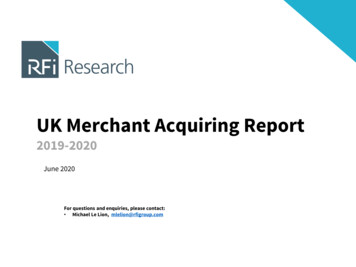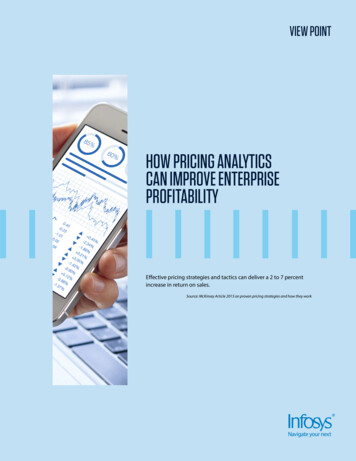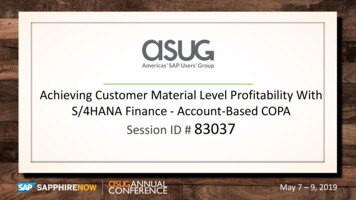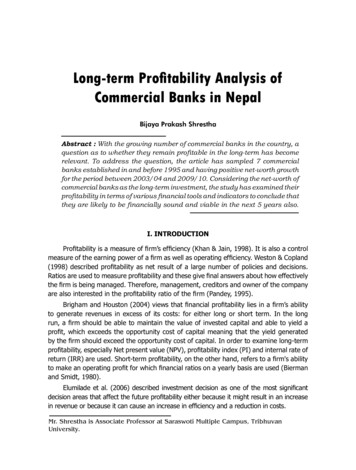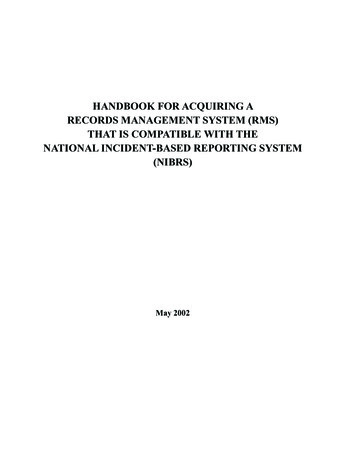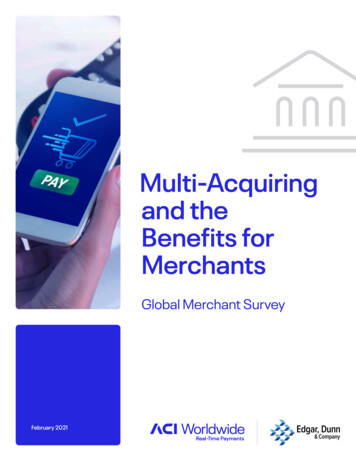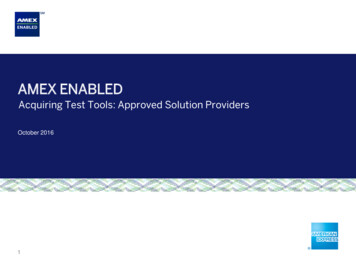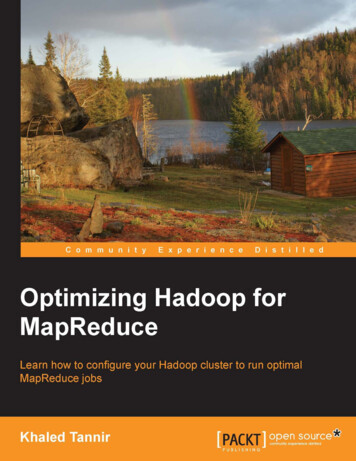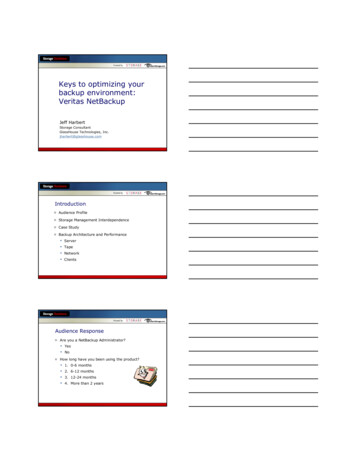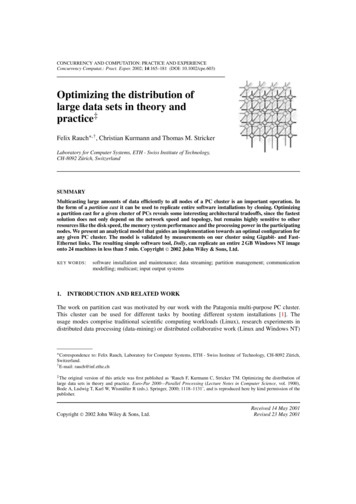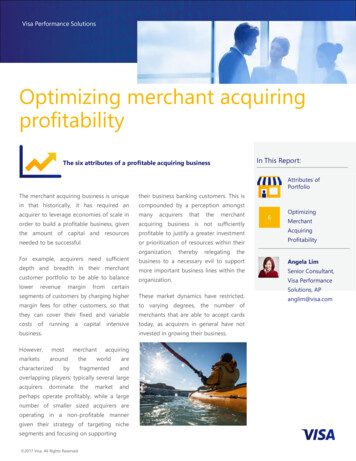
Transcription
Visa Performance SolutionsOptimizing merchant acquiringprofitabilityIn This Report:The six attributes of a profitable acquiring businessAttributes ofPortfolioThe merchant acquiring business is uniquetheir business banking customers. This isin that historically, it has required ancompounded by a perception amongstacquirer to leverage economies of scale inmanyorder to build a profitable business, givenacquiring business is not sufficientlythe amount of capital and resourcesprofitable to justify a greater investmentneeded to be successful.or prioritization of resources within theirFor example, acquirers need sufficientdepth and breadth in their merchantcustomer portfolio to be able to ization,thattherebythemerchantrelegatingSenior Consultant,organization.Visa Performancethey can cover their fixed and variablemerchants that are able to accept cardscoststoday, as acquirers in general have notintensivebusiness.However,marketsinvested in growing their ringworldarefragmentedandoverlapping players; typically several largeacquirersdominatethemarketandperhaps operate profitably, while a largenumber of smaller sized acquirers areoperating in a non-profitable mannergiven their strategy of targeting nichesegments and focusing on supporting 2017 Visa. All Rights Reserved.Profitabilitymore important business lines within theto varying degrees, the number ofcapitalAcquiringAngela Limmargin fees for other customers, so thataMerchanttheThese market dynamics have restricted,runningOptimizingbusiness to a necessary evil to supportsegments of customers by charging higherof6Solutions, APanglim@visa.com
Based on extensive research and insights gainedFuture whitepapers will address certain best practicefrom working with acquirers across the world, thisexamples within each of these areas.whitepaper will explore what Visa PerformanceSolutions believes are the basic themes for anacquirer to build a more profitable stand-alonemerchant acquiring business.The framework below outlines the attributes of aprofitable acquirer and the key themes discussed in thispaper.Optimizing Merchant Acquiring Profitability1. AcquiringStrategy andP&LFramework12. SalesChannels &SegmentationApproach3. MerchantPricingDiscipline &FlexibilityRobust Merchant Acquiring Strategy supportedby a P&L Framework4. MerchantProducts &Solutions5. MerchantRisk and FraudManagement6. EfficientOperations &SupportProcessesII. Supported by a Robust Organizational Structure:Dedicated staff and resources should be accountableSuccessful acquirers invest in setting up strongand deliver on their targets. A management functionfoundations to support their business in threeshould be put in place to provide strategic direction andspecific areas:executive focus to this part of the business, which isI. Establish a Well-Defined Merchant AcquiringBusiness Strategy and Plan:often neglected in unprofitable acquirers. For example,best practice acquirers may have implemented astructure where the Merchant Services Division reportsWith buy-in and support from the Board or seniorto a dedicated senior management executive who ismanagement on an ongoing basis, the strategyresponsible for the daily operations and profitability ofshould articulate the key areas of focus, including:the business, so that key opportunities or issues can be Performance: Establishing targets and measuringresults, having a strong segmentation discipline toevaluate the merchant portfolio This enables the organization to facilitate quickerdecisions, retain focus and foster a stronger appreciationof how the merchant acquiring business contributes toProduct: Building differentiation and innovationthrough a structured effort highlighted quickly and visibly to senior management.the organization.This is often overlookedby manyunprofitable acquirers.Channel: Ensuring the organization leverages allavailable channels to offer and cross sell relevantproducts to its merchant customersAcquirers should regularly update theirmerchantacquiring strategy to reflect the opportunities andchallenges at hand, with all the business units in theorganization aligned in this effort 2017 Visa. All Rights Reserved.2
III. Strong Culture and Discipline of MeasurementMany acquirers have not established the requireddiscipline and processes to measure the financialperformance for their business, and this hampers theability for the organization to appreciate andunderstand the contribution of the merchantacquiring portfolio. It is important to ensure thatstrategies are in place to assess the profitability sothat revenue generated from the Merchant AcquiringBusiness remains healthy, rather than crosssubsidizing revenue to support the overall bankingbusiness revenues and returns.Some acquirers exist solely to support ion the profitability contribution of theirmerchant acquiring business. Leading players enterinto the merchant acquiring business to achieve twoprimary goals of delivering net positive financialreturns to the organization while providing a product/ service that can serve their key institutional andsmall business customers.Best practice acquirers have set up a clearly definedand standalone P&L framework that they own, wheregross revenues can be accrued and direct andindirect costs from other parts of the organizationare attributed, so that there is a complete view onhow the business is performing, with autonomy,measurement and accountability.Although having a consistent P&L structure shouldguide and inform management on the revenue orexpense drivers that can be influenced to improveprofitability, many acquirers that Visa PerformanceSolutions have worked with globally have not set upa proper P&L in order to achieve this. 2017 Visa. All Rights Reserved.An example P&L structure should incorporate themeasurement, tracking and reporting of the followingrevenue and expense drivers, so that management canhave the required financial information and trends datato evaluate incremental revenue initiatives or exploreopportunities to reduce costs.Revenue DriversExpense DriversMerchant Service Fee orMerchant Discount Rate(MSF/MDR)Interchange and NetworkScheme FeesHardware / EquipmentDriven Fees (e.g. POSrental, Hosting orLicensing fees,Communication fees)Marketing & Sales (e.g.promotions, brochures,events)Miscellaneous fees(e.g. minimumthresholds, exceptions,chargeback handlingfees, manual processingfees)POS Terminals andNetworks (e.g. hardwareand infrastructure,switching cost, communications, maintenance,installation, depreciation)Value Added Service Fees(e.g. fraud moni-toringservice, projectimplementation fee,customized reportingtool, tokenizationservices)Merchant Support (e.g.call center, disputeprocessing, underwriting,online portal, supplies,merchant training)Exceptions and RiskControl (e.g. chargebacks,fraud, fraud monitoringsupport)Settlement andAccounting (e.g.reconciliation, statements)IT Delivery & Operations(e.g. Acquiring systems,gateways, stationery,merchant and stafftraining)Advanced acquirers perform P&L analysis on theirportfolio by clustering merchants within each categoryor size, such as distributing small restaurants intodifferent groups based on their respective behaviors.Such acquirers have invested in reporting capabilities tonot only track the financial performance and keybusiness drivers above, but have the capability tounderstand the profitability by specific merchantaccount and by certain segments, or clusters, such as theexample highlighted below. Having such a view on thebusiness will enable management to make moreinformed decisions on how to increase profitability.3
Cluster 5Cluster 4Cluster 3Cluster 2Cluster 1100%0%2% ofmerchants% of% of% ofvolume transactions income% of lowtransactionfeesWell Defined Sales and Segmentation StrategySuccessfulacquirersensure theyleverage thedistribution channels available to them across theentire organization, to generate new tion, some acquirers may not have access toas broad a range of channels such as a retail branchnetwork, direct sales agents or even independentsales organizations. However, it should be in theinterests of the acquirer to ensure their strategyincludes a well thought out plan to leverage multiplesales channels in order to optimize profitability. Aneffective merchant acquisition strategy will haveconsidered the following areasI.Segmentation% of% ofoperat- interchangeing cost% ofmargin% of fixedcostsFor example, most acquirers% ofprofit% oflossadopt a traditionalapproach of segmenting their portfolio based on size ofmerchant or business category, such as MerchantCategory Code (MCC). Given limited resources and staff,this then enables the acquirer to identify the highervalue and more profitable segments to acquire, oridentify segment deficiencies that need to be addressedas part of their sales strategy. The importance of havingclearly prioritized segments in the strategy will allow theacquirer salesforce to focus their efforts on the mostimpactful customers to recruit. Some acquirers focustheir efforts primarily on higher margin segments asthey may not have the resources to compete inmerchant segmentswhich require more complexsolutions while other acquirers focus on priority clustersor industries (e.g. government, medical) because theymight have a specialty there. Some acquirers in the US,It is essential for acquirers to manage their merchantfor instance, place a high priority on education segmentportfolio through the use of segmentation, as thismerchants given the average life of such merchants iswill allow them to prioritize and allocate their salesfound to be twice as long as a restaurant merchant.resources more effectively. 2017 Visa. All Rights Reserved.4
II.Motivated sales force:III.A key ingredient in driving incremental sales andprofitability is having the right sales programs inplace to ensure: All staff with responsibility for selling merchantproduct and services can be recognized centive program when they meet or cehaveWith the rapid development of technology and theexpanding reach of mobile devices, acquirers can usethese digital platforms to grow their distributionchannels and therefore gain easier and more costeffective access to new and different merchantcustomers, which would not have been possible untilrecently. For example Instead of relying on driving the majority of newmerchants through the traditional retail branchnetwork, leading acquirers today are building moresophisticated online websites that not only nts, but which incorporate an interactiveworkflow function that facilitates an efficientapplication experience for the merchant. Merchant sales staff also have access to intuitiveonline application portals, which they can easily useon their portable computer, mobile phone or tablet,to complete a merchant application alongside theprospective merchant. The availability of suchsolutions, enables the acquirer and their sales staff tocapture new customers in a more timely and costeffective manner, thereby reducing the time ofapplication to first transaction.target.developedaninfrastructure to not only track sales data likerevenue per merchant, but have the ability tocompensate sales staff through a tiered financialincentive structure based on profitability andrevenue generated per merchant. These practicesshould be supplemented through regular internalcommunications to recognize merchant sales staffon a non-monetary basis as well, such as staffevents, newsletters and awards. Leveraging new technology to drive salesSales staff across the organization understand themerchant acquiring product proposition andfeatures, the benefits to corporate and smallbusiness customers, and have the knowledge andskills to explain to customers confidently andclearly. Visa Performance Solutions has observedthat the most profitable acquirers have investedin comprehensive and effective merchant salestraining programs delivered regularly, in anonsite, remote and online environment to drivesales staff awareness and confidence in themerchant acquiring products. 2017 Visa. All Rights Reserved.IV.Collaborating with third partiesWith new merchant opportunities located in widegeographic areas and residing in many differentindustries, it has become imperative for acquirers topartner with entities outside their organization, such asIndependent Sales Organizations (ISO’s) and Third PartyProcessors (TPP’s), to increase the sales reach andproductivity. Although successful acquirers in the pasthave been able to rely on generating new merchantsthrough their retail branch presence or their direct salesstaff, with the proliferation of technology and players, itis becoming critical that acquirers build strong channelpartnerships to tap into new customer pools. Forexample, acquirers can quickly understand the needs ofspecific industries by, developing partnerships withspecialized software providers (e.g. accounting systemproviders, hospitality and beverage solution providers,car parking meter software solutions) and paymentfacilitators who aggregate payments on behalf of acommunity of smaller merchants (e.g. property rentalmerchants, small business enterprises)., This also helpsthem to differentiate themselves whilst drivingincremental sales and profitability to their business.5
V.Optimizing cross-sell opportunities:For acquirers who have the ability to tap into largecorporate or small business customers with otherlines of businesses in their organization, this is a richsource of new customer leads. The cost of acquiringa new merchant customer can be high, and theability to cross-sell a merchant acquiring product toan existing customer will drive improved profitabilityby eliminating such acquisition expenses. Bestpractice acquirers demonstrate the ability to leverageother parts of their organization to cross-sell theirproducts and solutions, and have developed businessplans and specific procedures to incentivizemerchant sales staff in these areas. For example,workflow systems have been developed to supportlead generation and data analytics reports aregenerated regularly so that a cross-selling target listis allocated to sales staff3Strong Discipline and Flexibility with MerchantPricingPerhaps the area that consumes the most attentionwhen acquirers evaluate their profitability is aroundpricing, as this is typically the most visible area thatdelivers immediate impact to an acquirer’s top-linefinancial performance. This usually involves anevaluation of the Merchant Service Fee (MSF) orMerchant Discount Rate (MDR). Visa’s research fromworking with acquirers globally estimates that theMSF/MDR line item can contribute between 60-90%of an acquirer’s total revenue. Profitable acquirerstypically adhere to the following guidelines when itcomes to merchant pricing:Ensure that pricing (especially MSF/MDR) iscompetitive.This is such a large revenue contributor in themarket, however it is equally critical that acquirers 2017 Visa. All Rights Reserved.protect their MSF/MDR revenue stream to sustain theirongoing viability. If acquirers offer MSF/MDR rates wellbelow industry average and or below the cost ofinterchange and direct costs, this may cause impact to therevenue stream expected merchant acquiring business. It isimportant for an acquirer to understand and appreciatetheir fully loaded cost per transaction, including direct andindirect costs, so that they know the fee levels they can offerto secure the customer without creating a commerciallyunprofitable situation.Deliver flexibility in the MSF/MDR pricingto accommodate for different types of merchants. Forexample, smaller sized merchants may prefer the simplicityof being quoted a bundled MSF/MDR for all card brandsaccepted or in some cases a fixed fee per month (based onachieving a certain number of transactions per month) asthis often allows for easier reconciliation for the merchant.However, some merchants may prefer to have morevisibility on pricing for different card brands and even cardtypes and are prepared to deal with different MSF/MDR, bybrand, channel or even card type. In some cases, othermerchants may prefer to be given wholesale pricing plusmarkup otherwise referred to as “interchange-plus margin”fees, or request for volume-based pricing options thatprovide for lower fees as processing volume increases. It istherefore critical for acquirers to be able to accommodateas many MSF/MDR options as they feasibly can, so as toattract and / or retain valuable customers. In order toachieve this, acquirers need to have access to a merchantacquiring system that caters for these pricing permutations,as well as underlying pricing policies and procedures tosupport this.Establish a transfer pricing mechanismbetween functions dealing with corporate, business or smallbusiness customers and the merchant acquiring P&L, toacknowledge the value the acquirer is bringing to thecustomer even if it is an internal cost to the organization.This type of arrangement builds accountability and visibilityto the acquirer so that the full value of the service can beaccounted for, and reported as part of the P&L. For theacquirers who have not implemented such a practice, itundervalues the service that the merchant acquiringfunction is bringing to the overall customer relationship,and therefore runs the risk of the merchant acquiringfunction being treated as simply a support function or anexpense item, rather than a revenue contributing businessto the organization.6
Develop the capability to levy a wide range offees outside of the MSF/MDRDespite their financial contribution to the P&L, bestpractice acquirers recognize that MSF/MDR revenueis not everything to their business and continuallylook at ways to generate other revenue sources tomatch the value added solutions and services theydeliver to merchants. For example: Consider imposing POS terminal fees (rental /purchased) to ensure merchants appreciate thevalue of the facility they use Account inactive fees should be considered todiscourage merchants from not utilizing theiraccount and facilities, therefore incurringadditional fixed costs for the acquirer Fees for the usage of value-added functions suchas secure storage, tokenization, multi-currencyprocessing on a pay-as-you-use basis. Consider imposing or pass on the indemnity offraud and chargeback fees to discouragemerchants from being negligent in managingtheir payment acceptance channels.In order to improve the profitability of their business,acquirers need to not only review their P&L regularly todynamically determine the merchant pricing needed toachieve financial returns while remaining competitive,but also be proactive in developing innovative pricingstrategies to support their sales and marketing efforts.4Leading acquirers have a comprehensive merchantpricing policy and structure set up that caters forflexible pricing models and allows additional fees tobe charged for value-added-services or pricingdiscounts. As customer expectations grow (e.g. beingoffered transparent pricing or pay-as-you-usepricing) and access to more advanced technologybecomes easier, the merchant pricing landscape willcontinue to evolve.For example, in the most developed merchantacquiring market in the United States of America, thelargest acquirers, especially those who use thirdparty providers for front-end authorization and backend settlement services, are levying many “permerchant” and labour intensive fees, such ascustomer service, terminal help desk, chargebacksand retrievals, as they look to offset lowertransaction pricing1 .Offer Diversified Range of Products and ServicesIn an industry where traditional payment processing hasevolved
executive focus to this part of the business, which is often neglected in unprofitable acquirers. For example, . fees, manual processing fees) POS Terminals and Networks (e.g. hardware and infrastructure, switching cost,
